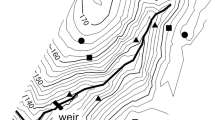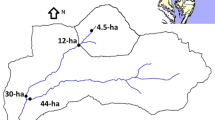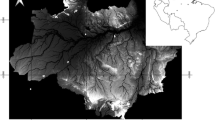Abstract
In forested streams, surrounding riparian forests provide essential supplies of organic matter to aquatic ecosystems. We focused on two pathways of particulate organic matter inputs: direct input from upper riparian forests and indirect lateral input from bank slopes, for which there are limited quantitative data. We investigated the inputs of coarse particulate organic matter (CPOM) and carbon and nitrogen in the CPOM into the uppermost reaches of a headwater stream with steep bank slopes in Hokkaido, Japan. CPOM collected by litter traps was divided into categories (e.g., leaves, twigs) and weighed. Monthly nitrogen and carbon inputs were also estimated. The annual direct input of CPOM (ash-free dry mass) was 472 g m−2, a common value for temperate riparian forests. The annual lateral CPOM input was 353 g m−1 and 941 g m−2 when they were converted to area base. This value surpassed the direct input. Organic matter that we could not separate from inorganic sediments contributed to the total lateral input from the bank slopes (124 g m−1); this organic matter contained relatively high amounts of nitrogen and carbon. At uppermost stream reaches, the bank slope would be a key factor to understanding the carbon and nitrogen pathways from the surrounding terrestrial ecosystem to the aquatic ecosystem.

Similar content being viewed by others
References
Allan JD, Castillo MM (2007) Stream ecology. Springer, Dordrecht
Anderson NH, Cummins KW (1979) Influences of diet on the life histories of aquatic insects. J Fish Res Board Can 36:335–342
Benda L, Hassan MA, Church M, May CL (2005) Geomorphology of steepland headwaters: the transition from hillslopes to channels. J Am Water Res Assoc 41:835–851
Berkman H, Rabeni CF (1987) Effect of siltation on stream fish communities. Environ Biol Fish 18:285–294
Cummins KW (1973) Trophic relations of aquatic insects. Annu Rev Entomol 18:183–206
Cummins KW, Wilzbach MA, Gates DM, Perry JB, Taliaferro WB (1989) Shredders and riparian vegetation. BioScience 39:24–30
Davies-Colley RJ, Hickey CW, Quinn JM, Ryan PA (1992) Effects of clay discharges on streams. Hydrobiologia 248:215–234
de Castro Vasconcelos M, Melo AS (2008) An experimental test of the effects of inorganic sediment addition on benthic macroinvertebrates of a subtropical stream. Hydrobiologia 610:321–329
Gomi T, Sidle RC, Richardson JS (2002) Understanding processes and downstream linkages of headwater systems. Bioscience 52:905–916
Gordon ND, McMahon TA, Finlayson BL, Gippel CJ, Nathan RJ (2004) Stream hydrology: an introduction for ecologists. Wiley, UK
Japan Meteorological Agency. http://www.data.jma.go.jp/obd/stats/etrn/index.php
Kochi K, Kagaya T (2005) Green leaves enhance the growth and development of a stream macroinvertebrate shredder when senescent leaves are available. Freshw Biol 50:656–667
Kochi K, Yanai S, Nagasaka A (2004) Energy input from a riparian forest into a headwater stream in Hokkaido, Japan. Arch Hydrobiol 160:231–246
Meyer JL, Strayer DL, Wallace JB, Eggert SL, Helfman GS, Leonard NE (2007) The contribution of headwater streams to biodiversity in river networks. J Am Water Res Assoc 43:86–103
Montgomery DR, Buffington JM (1998) Channel processes, classification, and response. In: Naiman RJ, Bilby RE (eds) River ecology and management: lessons from the Pacific coastal ecoregion. Springer, New York, pp 13–42
National Land Survey Division, Land and Water Bureau. http://tochi.mlit.go.jp/tockok/inspect/inspect.html
Pandian TJ, Marian MP (1986) An indirect procedure for the estimation of assimilation efficiency of aquatic insects. Freshw Biol 16:93–98
Richardson JS (1991) Seasonal food limitation of detritivores in a montane stream: an experimental test. Ecology 72:873–887
Sakaguchi Y, Takahashi Y, Omori H (1987) Rivers in Japan (in Japanese). Iwanami, JP
Shibata H, Mitsuhashi H, Miyake Y, Nakano S (2001) Dissolved and particulate carbon dynamics in a cool-temperate forested basin in northern Japan. Hydrol Process 15:1817–1828
Smock LA (1990) Spatial and temporal variation in organic matter storage in low-gradient, headwater streams. Arch Hydrobiol 118:169–184
Strahler AN (1957) Quantitative analysis of watershed geomorphology. Trans Am Geophys Union 38:913–920
Takeda H (2002) Ecological Sciences. Ecological Library 9 (in Japanese). Kyoto Daigaku Gakujutsu Shuppankai, JP
Webster JR, Meyer JL (1997) Stream organic matter budgets: introduction 7. In: Webster JR, Meyer JL (eds) Stream Organic Matter Budgets. J N Am Benthol Soc 16:1–161
Webster JR, Wallace JB, Benfield EF (1995) Organic matter processes in streams of the eastern United States. In: Cushing CE, Cummins KW, Minshall GW (eds) River and stream ecosystems. Elsevier, Amsterdam, pp 127–128, 137–138
Wood PJ, Armitage PD (1997) Biological effects of fine sediment in the lotic environment. Environ Manage 21:203–217
Acknowledgments
We thank colleagues in the Department of Environmental Design, Hokkaido Institute of Technology for their field work assistance. We also thank Dr. Cristina Canhoto for her comments on earlier version of the manuscript.
Author information
Authors and Affiliations
Corresponding author
Rights and permissions
About this article
Cite this article
Kochi, K., Mishima, Y. & Nagasaka, A. Lateral input of particulate organic matter from bank slopes surpasses direct litter fall in the uppermost reaches of a headwater stream in Hokkaido, Japan. Limnology 11, 77–84 (2010). https://doi.org/10.1007/s10201-009-0290-8
Received:
Accepted:
Published:
Issue Date:
DOI: https://doi.org/10.1007/s10201-009-0290-8




